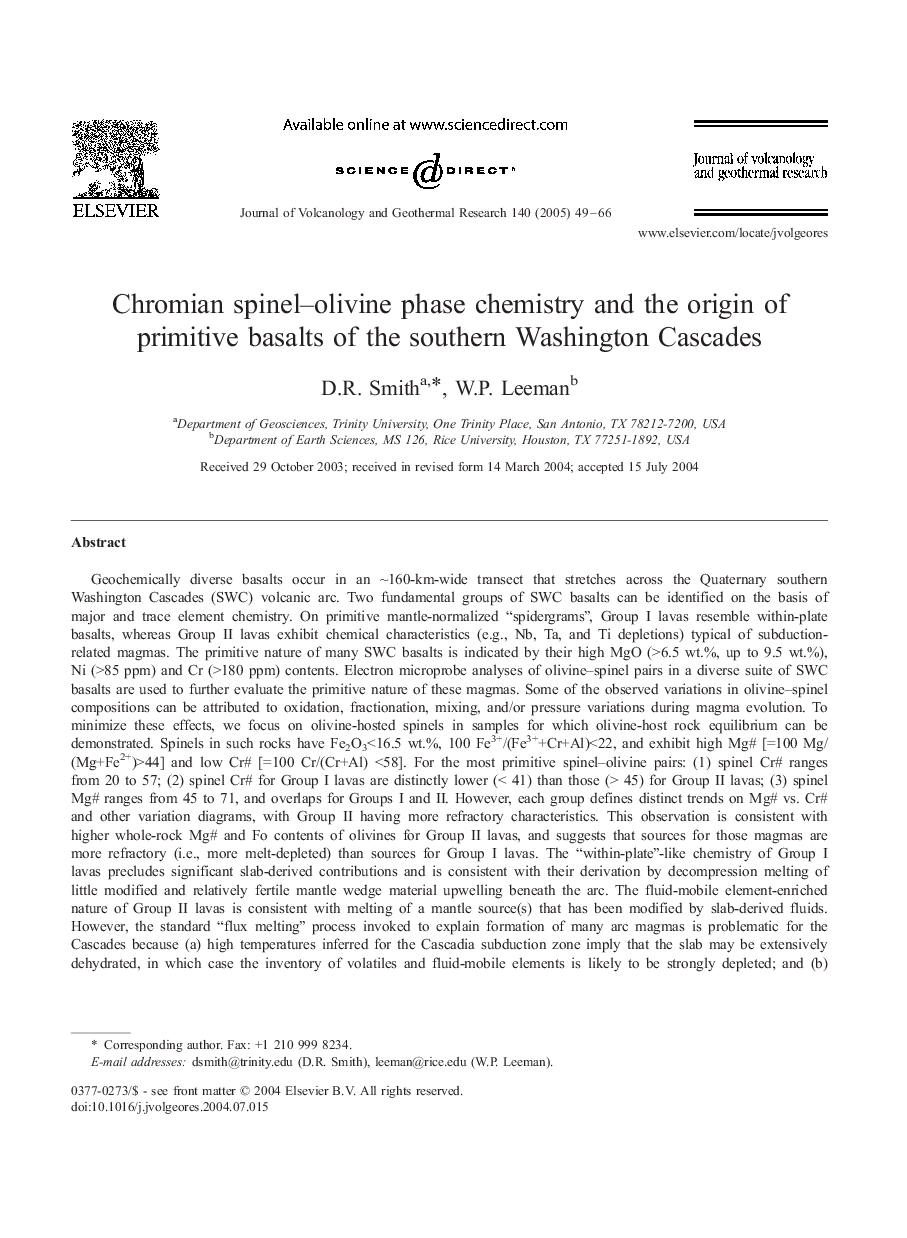| کد مقاله | کد نشریه | سال انتشار | مقاله انگلیسی | نسخه تمام متن |
|---|---|---|---|---|
| 9531150 | 1638502 | 2005 | 18 صفحه PDF | دانلود رایگان |
عنوان انگلیسی مقاله ISI
Chromian spinel-olivine phase chemistry and the origin of primitive basalts of the southern Washington Cascades
دانلود مقاله + سفارش ترجمه
دانلود مقاله ISI انگلیسی
رایگان برای ایرانیان
کلمات کلیدی
موضوعات مرتبط
مهندسی و علوم پایه
علوم زمین و سیارات
ژئوشیمی و پترولوژی
پیش نمایش صفحه اول مقاله

چکیده انگلیسی
Geochemically diverse basalts occur in an â¼160-km-wide transect that stretches across the Quaternary southern Washington Cascades (SWC) volcanic arc. Two fundamental groups of SWC basalts can be identified on the basis of major and trace element chemistry. On primitive mantle-normalized “spidergrams”, Group I lavas resemble within-plate basalts, whereas Group II lavas exhibit chemical characteristics (e.g., Nb, Ta, and Ti depletions) typical of subduction-related magmas. The primitive nature of many SWC basalts is indicated by their high MgO (>6.5 wt.%, up to 9.5 wt.%), Ni (>85 ppm) and Cr (>180 ppm) contents. Electron microprobe analyses of olivine-spinel pairs in a diverse suite of SWC basalts are used to further evaluate the primitive nature of these magmas. Some of the observed variations in olivine-spinel compositions can be attributed to oxidation, fractionation, mixing, and/or pressure variations during magma evolution. To minimize these effects, we focus on olivine-hosted spinels in samples for which olivine-host rock equilibrium can be demonstrated. Spinels in such rocks have Fe2O3<16.5 wt.%, 100 Fe3+/(Fe3++Cr+Al)<22, and exhibit high Mg# [=100 Mg/(Mg+Fe2+)>44] and low Cr# [=100 Cr/(Cr+Al) <58]. For the most primitive spinel-olivine pairs: (1) spinel Cr# ranges from 20 to 57; (2) spinel Cr# for Group I lavas are distinctly lower (< 41) than those (> 45) for Group II lavas; (3) spinel Mg# ranges from 45 to 71, and overlaps for Groups I and II. However, each group defines distinct trends on Mg# vs. Cr# and other variation diagrams, with Group II having more refractory characteristics. This observation is consistent with higher whole-rock Mg# and Fo contents of olivines for Group II lavas, and suggests that sources for those magmas are more refractory (i.e., more melt-depleted) than sources for Group I lavas. The “within-plate”-like chemistry of Group I lavas precludes significant slab-derived contributions and is consistent with their derivation by decompression melting of little modified and relatively fertile mantle wedge material upwelling beneath the arc. The fluid-mobile element-enriched nature of Group II lavas is consistent with melting of a mantle source(s) that has been modified by slab-derived fluids. However, the standard “flux melting” process invoked to explain formation of many arc magmas is problematic for the Cascades because (a) high temperatures inferred for the Cascadia subduction zone imply that the slab may be extensively dehydrated, in which case the inventory of volatiles and fluid-mobile elements is likely to be strongly depleted; and (b) Group I lavas occur at the volcanic front and appear to originate at depths proximal to the subducting slab. These geochemical and geometric constraints seem inconsistent with formation of Group II magmas by flux melting of the mantle wedge as commonly proposed for arcs. An alternative source for Group II lavas is chemically refractory lithospheric mantle that was previously metasomatized by earlier (40 Ma to present) Cascadia subduction and associated magmatism. Reheating and melting of such fluid-enriched domains could result from influx of hot decompression melts (Group I magmas). In either case, chemical and mineralogical evidence implicates two (or more) distinct processes of melt production and at least two distinct types of mantle source.
ناشر
Database: Elsevier - ScienceDirect (ساینس دایرکت)
Journal: Journal of Volcanology and Geothermal Research - Volume 140, Issues 1â3, 30 January 2005, Pages 49-66
Journal: Journal of Volcanology and Geothermal Research - Volume 140, Issues 1â3, 30 January 2005, Pages 49-66
نویسندگان
D.R. Smith, W.P. Leeman,